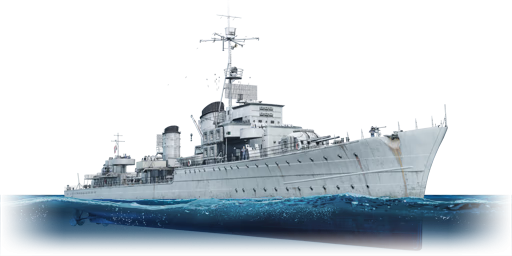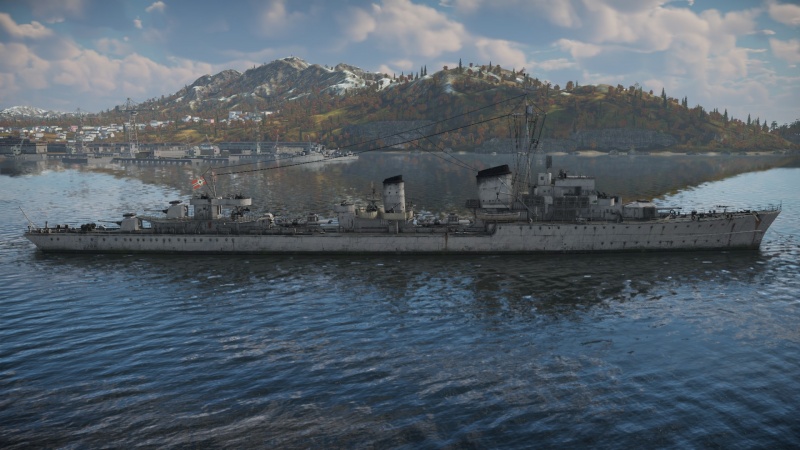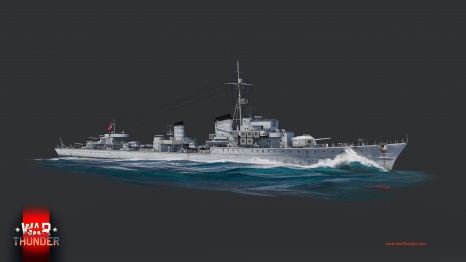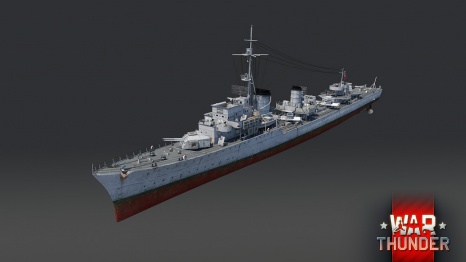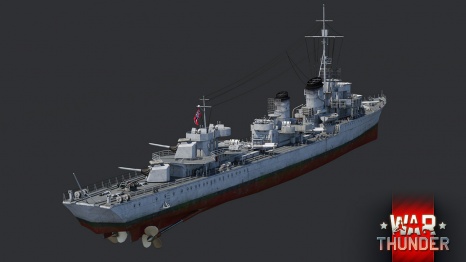Difference between revisions of "Z25"
Colok76286 (talk | contribs) (→Media: Added video) |
Math3matica (talk | contribs) (→Pros and cons) (Tag: Visual edit) |
||
| Line 71: | Line 71: | ||
<!-- ''Describe the technique of using this ship, the characteristics of her use in a team and tips on strategy. Abstain from writing an entire guide – don't try to provide a single point of view, but give the reader food for thought. Talk about the most dangerous opponents for this vehicle and provide recommendations on fighting them. If necessary, note the specifics of playing with this vehicle in various modes (AB, RB, SB).'' --> | <!-- ''Describe the technique of using this ship, the characteristics of her use in a team and tips on strategy. Abstain from writing an entire guide – don't try to provide a single point of view, but give the reader food for thought. Talk about the most dangerous opponents for this vehicle and provide recommendations on fighting them. If necessary, note the specifics of playing with this vehicle in various modes (AB, RB, SB).'' --> | ||
| − | The Type 1936A is essentially the [[Type 1936A (Mob)]] that sacrifice one single 15 cm turret for more secondary and AA mounts. Although it has less | + | The Type 1936A is essentially the [[Type 1936A (Mob)]] that sacrifice one single 15 cm turret for more secondary and AA mounts. Although it has less broadside firepower than its tech tree counterpart. It still retains its function as an excellent ship boasting massive firepower bow-on. |
Due to its non-existent armour, good muzzle velocity, slow firing and slow traversing guns, the Type 1936A is best used on medium or long ranges, where evasive manoeuvers can be made and enemies have a harder time hitting you. Following this, the Type 1936A should not be in the first line of attack, it should be played more like a support, staying further away, and making use of its longer range weaponry. When engaging at close range, the lack of firerate becomes apparent and multiple enemies from different directions can easily overwhelm the slow reacting destroyer, in these situations a precise shot in the ammorack can do the trick and is much more reliable than with smaller calibres. Furthermore, the large calibre is capable to overcome even the anti-fragmentation armour of American destroyers without losing much of your explosive power, and therefore countering those American vessels. | Due to its non-existent armour, good muzzle velocity, slow firing and slow traversing guns, the Type 1936A is best used on medium or long ranges, where evasive manoeuvers can be made and enemies have a harder time hitting you. Following this, the Type 1936A should not be in the first line of attack, it should be played more like a support, staying further away, and making use of its longer range weaponry. When engaging at close range, the lack of firerate becomes apparent and multiple enemies from different directions can easily overwhelm the slow reacting destroyer, in these situations a precise shot in the ammorack can do the trick and is much more reliable than with smaller calibres. Furthermore, the large calibre is capable to overcome even the anti-fragmentation armour of American destroyers without losing much of your explosive power, and therefore countering those American vessels. | ||
| Line 83: | Line 83: | ||
'''Pros:''' | '''Pros:''' | ||
| − | + | ||
| − | * | + | * High survivability due to a large crew size |
| − | * | + | * Engine compartment is covered by fuel tanks |
| − | * | + | * Powerful 15cm guns |
| − | * | + | * Secondary armament is effective against aircraft and small vessels |
| − | * | + | * Long range G7a torpedoes |
'''Cons:''' | '''Cons:''' | ||
| − | + | ||
| − | * | + | * The forward elevation angle of "Y" gun is blocked by "X" gun platform. |
| − | + | * Unsynchronized firing rate - "X", "Y" guns use ready racks but "A" gun does not. | |
| − | * | ||
| − | |||
| − | |||
== History == | == History == | ||
Revision as of 14:08, 9 April 2021
Contents
Description
The Type 1936A, Z25, 1945 is a premium gift rank III German destroyer with a battle rating of 4.3 (AB/RB/SB). It was introduced during Update "Hot Tracks" as a reward for Battle Pass: Season II, "Steel Centurion".
General info
Survivability and armour
The Type 1936A offers very little additional protection except the basic hull with 16 mm of steel armour and a superstructure with 8 mm of steel armour. The gunshields on the single 15 cm mounts are 12.7 mm thick and the gunshields on the 20 mm Flakvierlings measure 8 mm of armour, therefore only offering protection from small calibre machine gun fire.
The only significantly armoured part of the ship is the twin 15 cm turret on the front, with around 30 mm of armour frontally and 20 mm on the sides, offering enough protection to resist some early destroyer rounds, thus making it last longer in bow-in engagements.
Having no additional armour means most cannon, autocannon and even machine gun equipped ships can punch through its hull, meaning this destroyer isn't any more survivable than its predecessors in terms of armour.
Mobility
| Mobility Characteristics | |||
|---|---|---|---|
| Game Mode | Upgrade Status | Maximum Speed (km/h) | |
| Forward | Reverse | ||
| AB | |||
| Upgraded | 87 | 35 | |
| RB/SB | |||
| Upgraded | 71 | 29 | |
Due to one of the 15 cm gun were being replaced by AA mounts, the Type 1936A is slightly faster than the tech tree counterpart, the Type 1936A (Mob), and more comparable to Type 1936 (1941).
Modifications and economy
Armament
Primary armament
The main armament of the Type 1936A comes in the form of 4 powerful 15 cm/48 KC/36 cannons, in 2 single mounts aft and one twin mount at the front. The large calibre of these cruiser guns result in a rather slow reload of 7.5 seconds (with ace crew) and therefore a maximum of 8 rounds per minute. This however is compensated by the large amount of explosive filler and shrapnel the shells release on impact, as well as the noticeably better muzzle velocity retention, giving a much easier time aiming at longer ranges.
The turret traverse of a mere 10°/sec for the single mounts, and 7°/sec for the twin mount encourages a more careful approach to targets at longer range, as a quick turn with the guns at close range is simply not possible.
The HE shell has a TNT equivalent of around 3.91 kg and a muzzle velocity of around 835 m/s, making it a great choice for medium ranges against destroyers of any kind.
The second shell type, a semi-armour piercing capped shell has good penetration, a TNT equivalent of 3.32 kg and a muzzle velocity of around 960 m/s, making this one of the fastest destroyer shells in the game. Furthermore, this is the only destroyer shell able to reliably threaten a large portion of cruisers at ranges of around 5,000 meters. An accurate player will be able to ammorack most early interwar cruisers, or at least cripple them severely. The last shell, an explosive round with time fuse, can be used against aircraft if aimed carefully.
Secondary armament
The Type 1936A sacrifices one of the 15 cm cannon for extra aerial protection. Other than two twin 3.7 cm FlaK from the Type 1936A (Mob) that are placed at the place where the second 15 cm turret were once located, it also featured six single 3.7 cm FlaK mounts, four placed around the ship's second funnel and two on the aforementioned former turret mount. These have a fire rate of 30 round per minute and provide anti-ship capabilities against smaller patrol vessels and ship at close ranges with HE and AP, as well as good anti-air capabilities against low-ceiling planes.
Anti-aircraft armament
In addition to the 37 mm guns, the Type 1936A also featured four extra 20 mm emplacements (sixteen in total) in the form of dual 2 cm FlaK mounts. All four of which were located the front. The two quadmounts located front of the bridge and between the (former) second and third main gun placement. This gives the Type 1936A an impressive anti-air capabilities for close range encounters, although for longer ranges, this calibre is insufficient.
Other than that, the Type 1936A also featured a single 2 cm/65 C/38 autocannon mount directly at the front of the first main turret, this gun is nearly identical to that of the 20 cm FlaK.
Additional armament
The Type 1936A is equipped with basic two quadruple 533 mm G7a torpedo launchers placed at the centre of the ship. This torpedo has a speed of 81 km/h and a maximum range of 6 km. It takes 50 m to arm the torpedo. On-board is 358.4 kg TNT which causes a significant blow. The range can be extended up to 13 km with torpedo mode modification.
Usage in battles
The Type 1936A is essentially the Type 1936A (Mob) that sacrifice one single 15 cm turret for more secondary and AA mounts. Although it has less broadside firepower than its tech tree counterpart. It still retains its function as an excellent ship boasting massive firepower bow-on.
Due to its non-existent armour, good muzzle velocity, slow firing and slow traversing guns, the Type 1936A is best used on medium or long ranges, where evasive manoeuvers can be made and enemies have a harder time hitting you. Following this, the Type 1936A should not be in the first line of attack, it should be played more like a support, staying further away, and making use of its longer range weaponry. When engaging at close range, the lack of firerate becomes apparent and multiple enemies from different directions can easily overwhelm the slow reacting destroyer, in these situations a precise shot in the ammorack can do the trick and is much more reliable than with smaller calibres. Furthermore, the large calibre is capable to overcome even the anti-fragmentation armour of American destroyers without losing much of your explosive power, and therefore countering those American vessels.
Having the semi-armour piercing (SAP) shell equipped gives the Type 1936A another, more unique role, namely the role of a cruiser killer, being one of the few destroyers to be able to do so. Since your destroyer is the definition of a glass cannon, even more when facing cruisers, it is important to stay concealed behind islands or simply by not shooting whilst closing in to a range of around 4-6 km. A few salvoes into the sides of the cruiser where the ammo is located is usually enough for most early interwar cruiser designs like the USS Trenton (CL-11), the Krasny Kavkaz, or the Köln.
In exchange to one less main gun, the Type 1936A is equipped with a lot of small calibre mounts (ten 37 mm secondary guns and seventeen 20 mm AA guns in total) placed all over the ship. These guns is very deadly against enemy ship at close range (as it can cripple the enemy ship by depleting their crew and occasionally set the enemy ship on fire), various PT boats, and enemy aircrafts. While the AI gunners is able to reliably hit the enemy ship, smaller targets such as PT boats and occasionally aircraft may requires manual aiming to destroy them. It is advised to use the HE belts for the 37 mm against these targets as it can deal a good amount of damage via fragmentation blast.
Pros and cons
Pros:
- High survivability due to a large crew size
- Engine compartment is covered by fuel tanks
- Powerful 15cm guns
- Secondary armament is effective against aircraft and small vessels
- Long range G7a torpedoes
Cons:
- The forward elevation angle of "Y" gun is blocked by "X" gun platform.
- Unsynchronized firing rate - "X", "Y" guns use ready racks but "A" gun does not.
History
Devblog
The Z25 destroyer of the Type 1936A class was laid down at the beginning of 1939 and launched a year later, soon joining the 8th destroyer flotilla along with other ships of the 1936A series. The destroyer began combat operations as part of the German Baltenflotte to protect Swedish ports from the hypothetical possibility of break through by ships of the Soviet Baltic Fleet from the besieged Leningrad. Shortly thereafter, the Z25 was active in hunting for Arctic convoys in the Barents and White Seas, where it converged with Soviet and British ships. In February 1942, she took part in the famous Operation Cerberus - a daring dash from France to Germany of two German battleships and a cruiser under the cover of a destroyer group along the channel between France and England. Under constant raids by British aircraft and destroyer attacks, the Z25 not only survived, but was not significantly damaged at all. After this brilliant operation, the destroyer returned North to intercept Allied Arctic convoys. After discovering problems with the power plant, the Z25 went to Germany for repairs. From the beginning of 1944 and until the end of the war, she continued to serve in the Baltic Sea, taking part in both combat and evacuation operations.
At the end of April 1945, the destroyer Z25 was decommissioned from service and after the war was transferred to France, where it received the name "Hoche". Here she served for more than 10 years and even underwent a major modernization, but by 1957 the exploitation of the German veteran was recognized as economically unprofitable and the ship was decommissioned soon after. The destroyer was finally scrapped in 1961.
Media
- Images
- Videos
See also
Links to articles on the War Thunder Wiki that you think will be useful for the reader, for example:
- reference to the series of the ship;
- links to approximate analogues of other nations and research trees.
External links
Paste links to sources and external resources, such as:
- topic on the official game forum;
- other literature.
| Germany destroyers | |
|---|---|
| Torpedo boats | |
| Type 1924 | Jaguar · Leopard · Luchs |
| Type 1939 | T22 · T31 |
| Destoyers | |
| Type 1934A | Z12 Erich Giese · Z15 Erich Steinbrinck |
| Type 1936 | Z20 Karl Galster · Z22 Anton Schmitt |
| Type 1936A | Z25 · Z32 |
| Type 1936B | Z43 |
| Type 1936C | Z46 · Z47 |
| Germany premium ships | |
|---|---|
| Motor torpedo boats | LS 4 Esau · KM-5 · S-204 Lang · S-701 |
| Minelayers | VS-8 |
| Sub-chasers | M-802 |
| Frigates | Lübeck |
| Destroyers | Jaguar · Luchs · T31 · Z20 Karl Galster · Z25 · Z47 |
| Light cruisers | Karlsruhe |
| Heavy cruisers | Prinz Eugen |
| Battleships | SMS Nassau |


